

Liquid Dosage Form | Types, Excipients, Advantages, and Disadvantages
The liquid dosage form is designed to provide the maximum therapeutic response for those who have difficulty swallowing tablets and capsules and produce rapid therapeutic effects. The liquid is a solution with liquid preparation that contains one or more soluble chemical substances dissolved in a specific solvent.
Table of Contents
Types of Liquid Dosage Form:
Liquid dosage form types are further classified into Monophasic and Biphasic:

Monophasic Dosage form With Examples:
Monophasic liquid dosage forms can come in different forms. Some are simple mixtures called true solutions. These solutions are clear and smooth, made by dissolving a solid, liquid, or gas in another liquid. There are liquid medicines meant for inside your body, like syrups, mixtures , elixirs, and linctuses. And there are ones meant for outside your body, like gargles, mouthwashes, lotions, liniments, eye drops, ear drops, nasal drops, douches, and throat sprays.
Solutions : Solutions are the homogenous mixtures of one or more active ingredients dissolved in a liquid solvent, like in water. Examples of solutions like; Syrup and elixirs.

Syrups : Syrups are also a liquid dosage form with concentrated solutions that contain sugar or other excipients to enhance taste and palatability. These types of dosage forms are generally used for children and old-age-conscious persons. For example Benadryl syrup.
Elixirs : Elixirs are clear, sweetened hydroalcoholic solutions. They usually contain alcohol and are used to solubilize lipophilic (fat-soluble) active ingredients. Examples like; Some Antihistamine drugs that are manufactured as elixirs.

Tinctures : Tinctures are alcoholic or hydroalcoholic solutions that contain active herbal ingredients. They are commonly used in traditional and herbal medicine.

Drops : These are liquid formulations that are dispensed in small droplet form. They are often used for medications that require precise dosing, especially for infants or young children. Examples include Eye drops, nasal drops, and ear drops.

Gargles : Gargles are liquid medicines used to treat throat infections. They are meant to be used externally by diluting them with warm water. Gargles are held in the mouth for a short time before being spat out. They contain small amounts of phenol, which has antibacterial properties, and sometimes potassium chlorate for its mild astringent effects. Physicians often recommend phenol gargles and potassium gargles for mild throat infections.

Mouthwashes : Mouthwashes are liquid solutions with pleasant tastes and odors that are used to clean and freshen the mouth. They are commonly used for dental hygiene, but certain mouthwashes with antibacterial properties can also help treat gum infections. Mouthwash formulations typically include antibacterial agents, sweeteners, flavorings, alcohol, glycerin, and coloring agents.
Douches : Douches are liquid medications intended for use in body cavities. While the term “douche” usually refers to vaginal solutions, they can also be used to irrigate other body cavities like the eyes, ears, and nasal passages. Douches are primarily used to remove foreign particles from the body. In addition to cleansing properties, some douches have antiseptic and astringent properties. They are usually diluted with warm water before use.
Throat paints: Throat paints are thick liquid formulations used to treat mouth and throat infections. They typically contain glycerin as a base, which clings to the mucous membrane for a longer duration. Glycerin also provides a sweet taste to the throat paint. Common types of throat paints include boro glycerin, phenol glycerin, and tannic acid glycerin.
Biphasic Dosage form with Example:
Emulsions : Emulsions are mixtures of two immiscible liquids, such as O/W, or W/O. It contains stabilizers with an emulsifying agent.
Suspensions : These are heterogeneous mixtures where solid particles of the active ingredients are dispersed in a liquid medium. Suspensions require well shaking before administration to ensure an even distribution of the drug particles. For example, antacids that are being used for the stomach.

Excipients used in formulation of Liquid dosage forms:
Excipients play an important role in the formulation of Liquid dosage forms. Liquid formulation needs a meticulous blend of ingredients to perform various functions like wetting and solubilization, stabilization, and imparting suitable color, taste, and viscosity.
List of Excipients with Examples:
Below is the List of Excipients used in Liquid dosage forms with Examples:
A) Vehicles:
In pharmaceuticals, vehicles are the liquid bases that carry drugs and other excipients in a dissolved or dispersion medium.
1) Aqous Vehicles: Aqous Vehicles like; Water, Hydro-alcoholic, Polyhydric alcohols, and buffers. These may be thin and thick liquid syrup, mucilagis, or hydro-colloidal bases.
i) Water: It is the most useful solvent in the pharmaceuticals. it should be clear, odorless, and neutral with a slight deviation in pH. Purified water USP is allowed for usage as a vehicle for reducing impurities. Purified water is prepared by distillation, ion exchange, and Reverse osmosis.
ii) Alcohol (Ethyl Alcohol): Alcohol is the most useful solvent in pharmaceuticals. it is used as a hydro-alcoholic mixture that dissolved both water (USP) and alcohol (USP) in soluble form.
iii) Glycerol: It is an excellent solvent for numerous substances such as iodine, bromine, etc. It is a good vehicle for applying these substances to the skin. It is a clear, colorless liquid with thick syrup consistency, oily to the touch, odorless, very sweet, and slightly worn to taste.
It is also used to improve viscosity, taste, and flavor and also used as a co-solvent to increase the solubility of drugs that are low solubility with water.
iv) Propyl Glycol: Propyl glycol is another solvent for many organic compounds. it can be used as a flavoring and dye in cosmetics, toothpaste, shampoo, and mouthwash.
2) Oily Vehicles: Vegetable oils, mineral oils, organic oily bases, or emulsified bases.
B) Solublizer:
These excipients help dissolve the active pharmaceutical ingredient (API) in the liquid formulation.
1) Wetting agents and Surfactants: Wetting agents and Surfactants are used to create a homogenous dispersion of solid particles in liquid vehicles.
Example: Aquos vehicles like; Alcohol, and glycerin are frequently used to facilitate the removal of adsorbed air from the surface of the particles.
Non-Aqous like; mineral oil is commonly used as a wetting agent.
Typically hydrophobic API particles are not easily wetted even after the removal of adsorbed air. Hence it is necessary to remove the interfacial tension between the particles and the liquid vehicle by using surface active agents (Surfactant). eg. Sodium lauryl sulphate.
2) pH modifier and Buffering agents : The pH of an oral liquid formulation is a key point in regard to the pH control of a formulation. therefore, most of the formulations utilize a buffer to control potential changes in the solution pH.
Excipients like; citric acid, sodium citrate, or hydrochloric acid are used to adjust pH levels.
3) Suspending agents and Viscosity modifying agents: One of the most crucial factors involving in formulating a pharmaceutical suspension is the selection of appropriate suspending agents. Suspending agents impart viscosity and thus prevent particle sedimentation. For Examples: hydroxyethyl cellulose, xanthan gum, methylcellulose, and sodium carboxymethylcellulose.
4) Preservatives: They prevent the growth of microorganisms during product manufacture and self-life, although it may be most desirable to develop a “preservative-free” formulation to address the increasing concern about the biological activity of these compounds.
OR, It is a substance that is used for keeping food, drug chemical, and cosmetics in good condition for a long duration. for Examples: benzalkonium chloride, Benzoate, methylparaben, propylparaben, and chlorhexidine.
C) Stabilizers:
1) Anti-oxidants: Antioxidants are compounds that can reduce a drug that has been oxidized or compounds that are more readily oxidized than the agents they are to protect (Oxygen and scavengers). For Examples: Acetone, Ascorbic acid, Cysteine, Sodium thiosulphate, etc.
D) Organoleptic Addidives:
1) Flavouring agents: Flavouring agents are used to improve the taste of the drug product either by providing a more pleasant taste or by masking the unpleasant test.
Examples: Glycerin, Mint, Fruits, Honey, cherry, orange, and strawberry. etc.
2) Sweeting agents: Sweeting agents are the materials that are used to impart sweetness to the formulation and are referred to as sweetening agents.
Examples: Sucrose, Saccharin sodium, sorbitol, Glycerin, dextrose, etc.
3) Coloring agents: Coloring agents are added to liquid dosage forms to provide an appealing appearance or to aid in product identification., particularly in poisonous materials.
Examples: Carotenoids, anthocyanins, Chlorophyll, TiO 2, natural pigments, etc.
Advantages of Liquid Dosage Form:
- Easier to swallow and therefore easier for children and old age unconscious people.
- These types of dosage forms may be designed for any type of route of administration.
- It is more effective as compared to tablets and capsules because its absorption is fast.
- It is Homogeneous and therefore gives a uniform dose than suspension or emulsion which need to be shaken well before use.
- Flexible dosing.
Disadvantages of Liquid Dosage Forms:
- They are bulky, therefore it is difficult to transport and store.
- Some dosage form comes with unpleasant test and odour so that is difficult to mask.
- Less stable than solid dosage form because a color may change if not stored properly.
- Some drugs may be chances of poor solubility.
- An accurate measuring device like a spoon is needed to take liquid solution.
FAQs on Liquid Dosage Forms
A: Liquid dosage forms are medications in liquid form that are used for various purposes such as treating infections or maintaining oral hygiene.
A: Gargles are liquid medications specifically designed to treat throat infections. They are diluted with warm water and held in the mouth for a few seconds before being expelled. Gargles contain ingredients like phenol and potassium chlorate that help combat bacteria and provide a mild astringent effect.
A: Mouthwashes are liquid solutions used to clean and refresh the oral cavity. They are commonly employed for dental hygiene and can also be used to address gum infections. Mouthwashes typically consist of antibacterial agents, sweeteners, flavorings, alcohol, glycerin, and coloring agents.
A: Douches are liquid medications intended for instillation into body cavities. While they are commonly associated with vaginal solutions, douches can also be used to irrigate other cavities like the eyes, ears, and nasal passages. They serve the purpose of removing foreign particles and may possess antiseptic and astringent properties.
A: Throat paints are thick liquid formulations used to treat mouth and throat infections. They contain glycerin as a base in the solution, which helps the medication adhere to the mucous membrane for a longer duration. Throat paints often have a sweet taste due to the presence of glycerin in them including boro glycerin, phenol glycerin, and tannic acid glycerin.
A: Liquid dosage forms can be safe when used as directed by a medical professional. Consult your doctor before taking it, or read the instructions on the label.
A: Like any medication, liquid dosage forms can have potential side effects. The specific side effects can vary depending on the formulation and individual reactions. Consult your doctor before taking it, or read the instructions on the package insert for information on potential side effects.
A: The use of liquid dosage forms in children should be determined by a healthcare professional. They can provide appropriate guidance on dosage and usage based on the child’s age, weight, and specific medical condition.
A: Precautions may vary depending on the specific liquid dosage form. It is important to carefully read the instructions provided by the healthcare professional or the medication’s packaging. This includes information on dosage, dilution, storage, and any necessary precautions for safe and effective usage.

Naresh Bhakar is the Founder and Author at Pharmaguddu.com, bringing his extensive expertise in the field of pharmaceuticals to readers worldwide. He has experience in Pharma manufacturing and has worked with top Pharmaceuticals. He has rich knowledge and provides valuable insights and data through his articles and content on Pharmaguddu.com. For further inquiries or collaborations, please don’t hesitate to reach out via email at [email protected] .
Leave a Comment Cancel reply
Save my name, email, and website in this browser for the next time I comment.
- Basicmedical Key
Fastest Basicmedical Insight Engine
- BIOCHEMISTRY
- GENERAL & FAMILY MEDICINE
- HUMAN BIOLOGY & GENETICS
- MEDICAL DICTIONARY & TERMINOLOGY
- MICROBIOLOGY
- PATHOLOGY & LABORATORY MEDICINE
- PUBLIC HEALTH AND EPIDEMIOLOGY
- Abdominal Key
- Anesthesia Key
- Otolaryngology & Ophthalmology
- Musculoskeletal Key
- Obstetric, Gynecology and Pediatric
- Oncology & Hematology
- Plastic Surgery & Dermatology
- Clinical Dentistry
- Radiology Key
- Thoracic Key
- Veterinary Medicine
- Gold Membership
Dosage and dosage forms in herbal medicine
6 Dosage and dosage forms in herbal medicine Chapter contents Review of dosage approaches Oral dosage forms in herbal medicine The preparation of liquids Quality versus quantity Standardised extracts A mechanism for formulating liquids Comparing doses The subject of appropriate dose is probably the most controversial aspect of contemporary Western herbal medicine. Among Western herbal practitioners, many different dosage approaches are found from country to country and within countries. Underlying these different approaches are different philosophies about the therapeutic action of medicinal plants. At one extreme is the assumption that the therapeutic effect relies on a specific dose of the active chemicals contained in each particular plant. At the other extreme, emphasis is placed on the assumption that a herbal medicine, being derived from a living organism, carries a certain energy or vital force. The quality of this energy confers the therapeutic effect and hence the amount of actual herb is not as important, as long as some is present. Others perhaps feel that the active components act as catalysts to restore health and do not need to be present in pharmacological quantities. The low dosage approach should not be confused with homeopathy, although it has been influenced by this system. One important difference from homeopathy is that the therapeutic indications are not derived from the principle of similars and mainly come from traditional indications. Like homeopathy, this approach probably relies on a high degree of patient susceptibility to the medication. Both the high and low dosage approaches have their adherents who maintain that their respective systems give good results in the clinic. While it is inappropriate to label one approach as correct and the other incorrect (indeed, even high doses of herbs possibly also act through other unknown interactive factors), it is useful to review and contrast current and historical dosage approaches. By doing this, one can arrive at an appropriate dosage system for modern phytotherapy in that it is consistent with: • dosage ranges used in other important herbal traditions, e.g. China and India • dosages used by important historical movements in Western herbal medicine, e.g. the Eclectics • dosages currently recommended in pharmacopoeias • dosages established from pharmacological and clinical research. In any discussion of herbal doses, the influence of dosage form and quality of preparations must also be considered, as should the mechanics of formulation and prescription writing. Review of dosage approaches Traditional Chinese medicine The daily dose for individual non-toxic herbs in traditional Chinese medicine is usually in the range of 3 to 10 g, given as a decoction or in pill or powder form. 1 Often higher doses are prescribed by decoction than for pills, as might be expected since not all active components readily dissolve in hot water. 2 (Pills generally consist of the powdered herb incorporated into a suitable base.) Herbs are invariably prescribed in formulations. Doses for such formulations are about 3 to 9 g taken three times daily but can be higher in the case of decoctions. For each individual herb, a wide dosage range is usually given in texts. (This applies for all herbal systems.) One reason for this is that if a herb is used by itself or with just a few other herbs, a larger dose is used than when it is combined with many other herbs. 2 Dose also varies according to the weight and age of patients and the severity or acuteness of their condition. Recently, a more processed form of dosage has become popular among practitioners of Chinese medicine. This involves the prescription of formulas in a granulated form. The granules are prepared by drying or freeze-drying decoctions, that is aqueous extracts, of herbal formulas. Usually 2 g of granules is prescribed three times daily, which corresponds to about 6 to 10 g of original dried herbs per dose. Some herbs, or closely related species, are used in both Chinese and Western herbal medicine. Table 6.1 1, 3, 4 compares dosages for a few of these herbs. Table 6.1 Comparison of dosages used in Chinese and Western herbal medicine Herb Chinese dosage 1 g/day Western dosage 3, 4 g/day Ephedra sinica 3–9 3–9 (extract) 3–12 (decoction) Zingiber officinale 3–9 0.75–3 (decoction) 0.38–0.75 (tincture) Taraxacum mongolicum 9–30 6–24 (decoction) 3–6 (tincture) Glycyrrhiza uralensis 3–12 3–12 (decoction) 6–12 (extract) Rheum palmatum 3–6 2.3–4.5 (decoction) 1.8–6 (extract) Note: For dosages of tinctures and extracts given three times daily, the corresponding amount of dried herb per day has been calculated. In general, the similarity in the dosage range between the different systems is striking. Discrepancies do exist for Zingiber and Taraxacum, which in the case of Zingiber can be explained by a higher content of the active components in the alcoholic tincture compared to the decoction, and, in the case of Taraxacum may be a reflection on the different species used. Ayurveda Ayurveda often involves complex formulations which are prepared over several days and can contain many herbal and mineral components. Consequently, there is more dosage diversity than for Chinese medicine. Dosage ranges for individual non-toxic herbs are generally in the region of 1 to 6 g/day as powders or tinctures, with higher doses often recommended for decoctions. 5 Eclectic medicine Eclectic medicine was a largely empirical school of medicine which developed in America during the 19th century. 6 The movement was most prominent for a brief period from the late 19th to the early 20th centuries, when there were several teaching universities and many eminent scholars in the USA. Although the Eclectics used simple chemical medicines such as phosphoric acid, they mainly prescribed herbal medicines. Their knowledge of materia medica was their greatest contribution to Western herbal medicine; for example, herbs such as Echinacea and golden seal were made popular by them after observation of their use by the Native Americans. The Eclectics tended to use higher doses than those recommended in current texts and pharmacopoeias, although the ranges tend to overlap. Table 6.2 compares dosages currently used 3, 4 with those found in Eclectic texts 7, 8 for alcoholic extracts of herbs. Table 6.2 Comparison of dosages used by the Eclectics and modern dosages Herb Eclectic dosage 7, 8 g/day Current dosage 3, 4 g/day Euphorbia hirta 1.8–10.8 0.36–0.9 Echinacea angustifolia 0.9–5.4 0.75–3.0 Hydrastis canadensis 0.9–10.8 0.9–3.0 Passiflora incarnata 1.8–10.8 1.5–3.0 Valeriana officinalis 2.1–6.0 0.9–3.0 Rumex crispus 1.8–10.8 6.0–12.0 Viburnum opulus 3.6–10.8 6.0–12.0 Serenoa repens 2.7–10.8 1.8–4.5 Note: The corresponding amount of dried herb per day has been calculated from recommended dosages for fluid extracts. The British Herbal Pharmacopoeia The British Herbal Pharmacopoeia 1983 (BHP) carries extensive dosage information for individual herbs and is generally regarded as an important traditional reference on this subject for Western herbal practitioners. Dosages given in the BHP were derived from earlier texts such as the British Pharmacopoeia (BP) and the British Pharmaceutical Codex (BPC) but also resulted from a survey of herbal practitioners. More recently, the British Herbal Compendium (BHC) has been published in two volumes, with dosage information for the practitioner. 9, 10 The doses given by the BHP 1983 contain some inconsistencies. The main problem is that doses for tinctures often do not correlate to corresponding doses for liquid extracts. For a 1:1 extract and a 1:5 tincture of a particular herb to correlate in terms of dose, the dose range for the tincture should be five times that of the extract, since it is theoretically five times weaker. This problem contrasts with other pharmacopoeias such as the BPC 1934 where the correlation is generally, but not exactly, observed. Some examples that highlight this problem are provided in Table 6.3 . Table 6.3 Comparison of extract and tincture dosages in the BHP 1983 The poor correlation demonstrated in Table 6.3 , where in the case of Eupatorium purpureum the tincture dose is actually less than the extract dose, probably arises for two reasons: 1. As stated above, the BHP 1983 doses were in part derived from a survey of herbal practitioners. It is probable that there were different dosage philosophies between practitioners using extracts compared to those using tinctures. Hence, a correlation should not be expected. 2. Tinctures are manufactured using different techniques to 1:1 fluid extracts. This is particularly important. Fluid extracts can be prepared by reconstituting more concentrated extracts, rather than the traditional method of reserved percolation. In either case, the heat or vacuum used in concentration can rob the preparation of important active chemicals. Tinctures better preserve the activity of the whole plant because they are made without heat or a concentration procedure. Fluid extracts were also often manufactured using lower alcohol strengths than tinctures, and important active components may therefore not be extracted from the starting plant material. The result of these factors is that a 1:1 fluid extract can have an activity which is much less than five times that of a 1:5 tincture. This will be dealt with in more detail in the part of this chapter that discusses liquid preparations. Since tinctures better preserve the chemical profile of the dried herb, more credibility should be given to the tincture doses when using the dosage ranges in the BHP 1983. Commission E and ESCOP monographs Under the direction of the German Health Department, the Commission E prepared a series of monographs on commonly used medicinal herbs during the 1980s. The Commission E was an expert committee consisting of doctors, pharmacologists, pharmacognocists and toxicologists from both academia and industry. If a herb did not receive a positive monograph from the Commission E, it could not be readily registered as a medicine in Germany. In the preparation of a monograph, the Commission E took into account relevant traditional use as well as scientific research. A positive monograph for a herb also included dosage information. Many of the monograph doses are for infusions or decoctions since this reflects the common use of teas in the German marketplace. 11 Such daily doses are usually in the range of 2 to 10 g. Occasionally a monograph will specify a dose for a herb in terms of major active constituents; for example, for Ephedra the daily dose is 45 to 90 mg of alkaloids (about 4 to 8 g of herb) which is similar to the range in Table 6.1 . Occasionally, where tincture and extract doses are given by the Commission E, there is not always a good correlation. For example, the single dose for valerian tincture is 1 to 3 mL and yet the single dose for a fluid extract is 2 to 3 mL. The reasons for this may be the same as those discussed above for the BHP 1983. The Scientific Committee of ESCOP (European Scientific Cooperative of Phytotherapy) has published a series of herbal monographs. 12, 13 These were compiled by an international team of expert authors and represent a major contribution to the harmonisation of standards for herbal medicines across the European Union. These monographs contain useful dosage information reflecting the European situation and have been taken into account for the dosage recommendations in this text. Clinical trials The clinical trial is arguably the best way to determine the effective dose of either a single herb or a herbal formulation. This will not always be applicable to traditional medicine, however, since prescriptions are usually prepared on an individual basis. Also, a clinical trial does not necessarily determine the optimum dose. However, it does confer a relative certainty to the clinical results. That is, at a given dose of a given preparation a certain percentage of patients are likely to respond; for example, Ginkgo biloba standardised extract at 120 mg/day (which corresponds to about 6 g/day of dry leaves), given for 2 months, will improve intermittent claudication in 60% of patients. 14 Sometimes the clinical trial has used a standardised extract of the herb which can then be correlated to the whole herb; for example, silymarin in liver disorders at 240 mg/day corresponds to 8 to 16 g/day of Silybum marianum seeds. 15 The low dosage approach Currently in the USA, New Zealand, parts of Europe (especially among homeopaths) and to some extent Australia, there are practitioners who prefer to prescribe drop doses of 1:5 or even more dilute tinctures. It is useful to examine the possible origins of this approach. In Europe, homeopaths often use combinations of herbal mother tinctures in drop dosage, for example, ‘drainage’. This approach is sometimes incorrectly labelled as ‘phytotherapy’. In the USA a more direct influence comes, ironically, from a development of Eclectic medicine. In 1869, the Eclectic physician John Scudder proposed the concept of ‘specific medication’. 7 With this concept, medicines were matched specifically to the symptom picture of the patient and then given in the minimum dose required. Although this system may seem similar to homeopathy, there were important differences. 16 Material doses were always used, albeit lower than those prescribed by other Eclectics, and the prescription was not based on the law of similars. However, like classical homeopathy, there was a tendency to use only one medicine at a time. Scudder initially proposed that ‘specific medicines’ should be tinctures prepared from the fresh plant. 16 A fresh plant tincture is sometimes still called a ‘specific tincture’. Hence, the approach of using drop doses of tinctures, especially fresh plant tinctures, also comes from Scudder. Although Scudder’s system of specific medication was seen as an important development in Eclectic medicine, it was considerably modified by Lloyd. 17 Lloyd felt that drop doses of tinctures were too low and described the preparations proposed by Scudder as ‘superficial’. Lloyd proceeded to develop elaborate herbal preparations which were concentrated, semi-purified liquids. He also called these ‘specific medicines’ and they were widely adopted by Eclectic practitioners. However, in the early 20th century English herbalists aligned themselves with the American physiomedicalists in using simpler formulations, because Lloyd’s specific medicines proved too costly to import. Lloyd sometimes used solvents other than ethanol and water in the preparation of his specific medicines. 17 His methods were kept secret and even today are not widely known. Lloyd writes: ‘The aim has been to exclude colouring matters … and inert extractive substances also from these preparations …’. In this sense, he was tending towards the concept of orthodox drugs. However, his preparations were still chemically complex and ‘very characteristic’ of the original herb. 17 According to Felter, the specific medicines developed by Lloyd were at least eight times stronger than 1:5 tinctures. 7 It is these highly concentrated preparations which were generally used by Eclectic physicians in drop doses, and even then doses could be quite high – up to 60 drops (3 mL) three times daily. 7 In conclusion, the use of drop doses of tinctures, especially fresh plant tinctures, originated in response to the availability of more concentrated specific medications and was not representative of the general practice of Eclectic medicine, nor initially a challenge to traditional dosages. The current system in the UK In the UK in the past herbalists used fluid extracts, usually prepared using heat or from concentrates. However, among newer practitioners in the 1980s there was disenchantment with these preparations because of their inconsistent quality. These practitioners instead adopted the use of 1:5 tinctures. Usually, formulations of tinctures are prescribed at doses of 2.5 to 5 mL three times daily. However, BHP 1983 doses for tinctures can only be achieved by this approach if the formulation contains one to three herbs (see Table 6.3 for examples). Unfortunately, this restriction is usually not followed and it can be concluded that the move to tinctures has resulted in the use of lower doses. A rational system for modern phytotherapy The dosages used by the traditional systems of India and China, by most of the Eclectics and those established by clinical trials or recommended by expert committees or in pharmaceutical texts all tend towards the higher end of the dosage spectrum. Such an agreement should not be ignored if there is to be consistency in modern phytotherapy. If liquid preparations are to be used, then the BHP 1983 is an appropriate guide. However, as discussed above, more credibility should be given to the tincture doses. The difficulty in using 1:5 tinctures is the large volumes which are required to achieve BHP doses for multi-herb formulations. One way to overcome this problem is to make a more concentrated preparation but without the use of heat or vacuum. Such a preparation would be more akin to a 1:5 tincture than a fluid extract, since it would better reflect the chemical characteristics of the starting herb. The most concentrated preparation which can be achieved from a dried herb without using heat or vacuum concentration, and yet achieving high extraction efficiency, is a 1:2. A process of cold percolation is necessary to achieve a 1:2 extract. Dosages for 1:2 extracts can be calculated as 0.4 of the dose for 1:5 tinctures, since they are 2.5 times stronger. This approach enables the use of multi-herb formulations consistent with BHP and BHC dosage guidelines. For special preparations, such as herbal extracts standardised for active components, dosages established by clinical trials should be followed. Oral dosage forms in herbal medicine It is worth examining the relative advantages and disadvantages of the various oral dosage forms used by practitioners of Western herbal medicine. Liquids Liquid preparations have considerable advantages and are widely used. The main advantage is the easy preparation of formulations for each individual patient (extemporaneous dispensing). The other considerable advantage of liquids is that, if properly prepared, they involve minimal processing and truly reflect the chemical characteristics of the herb in a compact, convenient form. They also confer considerable dosage flexibility, which is especially relevant when prescribing low doses for small children. Liquids are readily absorbed and are convenient to take. Superior bioavailability is also an under-researched advantage of herbal liquids. When a solid dosage preparation is ingested, it must first disintegrate. The plant’s phytochemicals need to dissolve in digestive juices (and the water simultaneously imbibed with the tablet or capsule) in order to be absorbed by the body. Research has demonstrated that there is a relationship between the rate and degree of dissolution of the phytochemicals in a solid dosage preparation and their ultimate absorption into the bloodstream. The advantage of herbal liquids is that the all-important phytochemical constituents are already in solution. The main disadvantage of liquids is taste, although in the case of bitters the taste is an essential part of the therapy. The taste problem is somewhat exaggerated by some patients. Most patients get used to the taste of their mixture and some even grow to like it. If taste becomes a problem, there are flavouring preparations available and these are particularly useful for children. It is helpful to ask patients before prescribing if they mind taking strong-tasting liquids. This will draw a commitment from those who say it is not a problem and guide the clinician to solid dose alternatives if the answer is otherwise. The way a herbal liquid is taken can minimise the experience of any unpleasant taste. The most important factors are the contact time of the remedy in the mouth and the intensity of the contact. Some practitioners claim that absorption from the oral cavity is often part of the activity of herbal preparations. So it may in fact be preferable to prolong the contact time. But from the point of view of taste, it should be minimised. To reduce the intensity of the contact, the herbal liquid must be diluted. However, if it is diluted too much the contact time will be too long. So there is a trade-off between intensity and contact time. It is recommended that a 5 mL dose is diluted with around 10 mL of water or fruit juice. This can easily be swallowed in one go, making the contact time minimal. Another way to reduce further the intensity of the contact is to suck on some ice beforehand. This deadens the taste buds and the olfactory nerve. Chilling the medicine beforehand and adding chilled water is another way to reduce the taste intensity. Contact time can be further reduced by immediately rinsing the mouth with water or fruit juice. About 50 mL can be quickly consumed immediately after the liquid is taken. To best achieve this, the diluted liquid should be in one hand and the rinse in the other. They are then consumed in a one–two action, as quickly as possible. Using this technique, taste can be dramatically minimised and few patients complain of any problem. For herbs with a lingering aftertaste, eating something afterwards will help. Another option to avoid the taste of a herbal liquid is to put the liquid (undiluted) into a hard gelatin capsule using a dropper. The capsule will soften slowly over the next hour, so it can be conveniently consumed well before this happens. Another disadvantage of liquids that applies in a few cases is the alcohol content. This is if the patient is allergic to alcohol or is an ex-alcoholic who does not wish to take alcohol in any form. Also, some strict Muslims will also not take alcohol, even in medicines. Only a very small minority of patients are genuinely sensitive to alcohol. In others, a presumed sensitivity is only an exaggerated reflex response to the medicine. This can usually be alleviated by lower doses at greater frequency, taken with copious water or food. Usually the small quantities of alcohol involved will not affect a mildly damaged liver – a 5 mL dose contains as much alcohol as about one-sixth of a glass of beer or wine. The alcohol content of liquids is not a problem for children since correspondingly lower amounts of liquids, and hence alcohol, are prescribed. Use of alcohol in herbal liquid preparations is important since it is a good solvent for herbal active components and an excellent preservative. This is discussed in more detail later in this chapter, together with a brief review of the history and context of ethanol use in herbal preparations.
Share this:
- Click to share on Twitter (Opens in new window)
- Click to share on Facebook (Opens in new window)
Related posts:
- Validating herbal therapeutics
- A systematic approach to herbal prescribing
- Herbal therapeutic systems
- How to use the monographs
Stay updated, free articles. Join our Telegram channel
Comments are closed for this page.

Full access? Get Clinical Tree

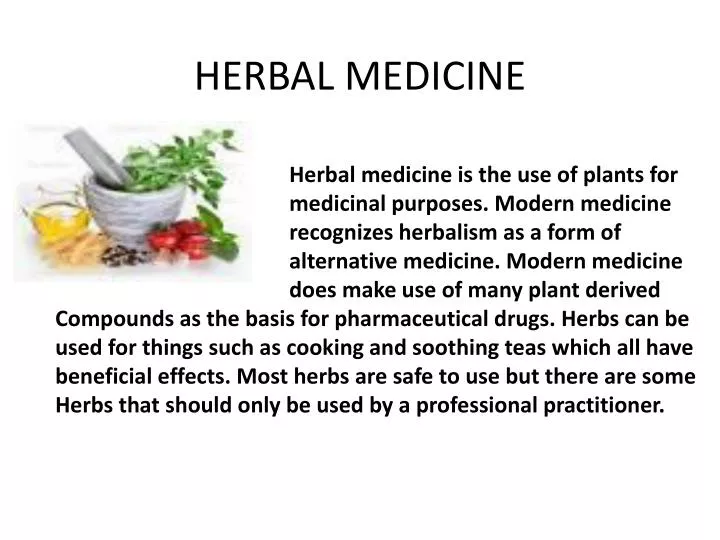
HERBAL MEDICINE
Jul 31, 2014
861 likes | 4.13k Views
Herbal medicine is the use of plants for medicinal purposes. Modern medicine r ecognizes herbalism as a form of a lternative medicine. Modern medicine d oes make use of many plant derived . HERBAL MEDICINE. Compounds as the basis for pharmaceutical drugs. Herbs can be

Share Presentation
- org international journal
- herbal medicine
- florajournal com
- soothing teas
- alternative medicine

Presentation Transcript
Herbal medicine is the use of plants for medicinal purposes. Modern medicine recognizes herbalism as a form of alternative medicine. Modern medicine does make use of many plant derived HERBAL MEDICINE Compounds as the basis for pharmaceutical drugs. Herbs can be used for things such as cooking and soothing teas which all have beneficial effects. Most herbs are safe to use but there are some Herbs that should only be used by a professional practitioner.
There are various herbs that we use every day such as parsley which is one of the richest sources of vitamin C. It is also an effective diuretic helping the body the body to rid itself of excess water. It also helps to calm the Gastrointestinal system and is a good source of vitamin K.
Chamomile is a widely used herb. It is commonly used as a gentle relaxant. This herb is pleasant tasting which makes it good for a tea preparation. The recommended amount for tea would be 1 cup of water to 2 teaspoons of the herb let that soak for 10-15 minutes. Chamomile is also great for symptoms such as indigestion and Gastritis.
Herbs such as Lobelia can be dangerous to use. It is important to research an herb you are unfamiliar with before using it. Herbs Such as Lobelia are best left to a professional for use. Lobelia is a systemic relaxant. It is also used for cramps and as a respiratory stimulant. At high doses it is used as an emetic. It is commonly used as a tea which as a treatment it is generally taken 3 times a day, ½ teaspoon in 1 cup of water. Lobelia is similar to nicotine. It is considered toxic because of its strong emetic effect.
You can find out more about herbs and herbal therapy at the Following websites. The American Botanical Council http://cms.herbalgram.org International Journal of Herbal Medicine http://www.florajournal.com The National Center for Complimentary and Alternative Medicine, NIH http://nccam.nih.gov Sage Mountain Herbal Retreat Center http://www.sagemountain.com
Some good educational resources about herbal therapy are available such as The Essential Herbal http://www.essentialherbal.com The Herb Quarterly http://www.herbquarterly.com
REFERENCES Gladstar, R. (2001). The Science and Art of Herbalism. Hoffman, D. (1996). Holistic Herbal. Element.
- More by User
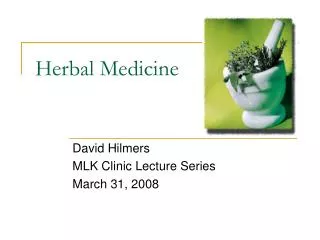
Herbal Medicine
Herbal Medicine. David Hilmers MLK Clinic Lecture Series March 31, 2008. Objectives. To discuss the efficacy and use of some common herbal remedies To learn about the regulation and safety of herbal medicines in the US
1.35k views • 29 slides

Herbal Medicine. Megan Kearney BVSc VetMFHom MRCVS DipHerbMed MNIMH Medical Herbalist www.holisticherbs.co.uk. What is Herbal Medicine?. Use of whole plants in the promotion of health and the treatment of disease. Primary medicine of over 80% of the world's population
833 views • 15 slides

DEVELOPMENT OF HERBAL MEDICINE
DEVELOPMENT OF HERBAL MEDICINE. DEVELOPMENT OF HERBAL MEDICINE. SHUBHAM SINHA GROUP - 2. Early 19 th Century. From the earliest times, medicinal plants have been crucial in sustaining health & well-being of humans E.g. Linum ussitassimum Magical abilities & medicinal benefit
769 views • 37 slides

Herbal Medicine. By Ashley Lindemann Kaplan University. Overview. Herbal Medicine is the use of plants (or plant parts) for their medicinal effects; whether it is in an attempt to treat an ailment, symptoms of an ailment or to promote wellness and improve health ( Micozzi , 2011 )
711 views • 11 slides
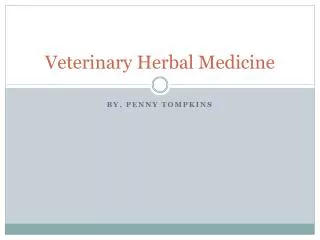
Veterinary Herbal Medicine
Veterinary Herbal Medicine. By, Penny Tompkins. Description. Herbal medicine is a traditional practice dating back over 5000 years. It is a system of using whole plants and plant extracts in the treatment of disease and maintaining health.
1.62k views • 12 slides
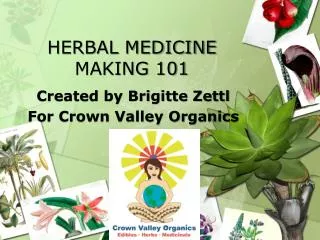
HERBAL MEDICINE MAKING 101
HERBAL MEDICINE MAKING 101. Created by Brigitte Zettl For Crown Valley Organics. Herbs in History. Medicinal plants have aided our survival for all of human history Allopathic medicine has only existed for the last 2 centuries
371 views • 15 slides
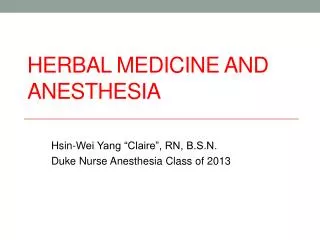
Herbal Medicine and Anesthesia
Herbal Medicine and Anesthesia. Hsin -Wei Yang “Claire”, RN, B.S.N. Duke Nurse Anesthesia Class of 2013. Objectives. Discuss types of complementary and alternative medicine (CAM) Review herbal medicine regulations
1.08k views • 43 slides
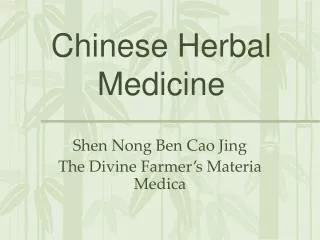
Chinese Herbal Medicine
Chinese Herbal Medicine. Shen Nong Ben Cao Jing The Divine Farmer’s Materia Medica. In Chinese Culture there are three legendary figures that are revered. Huang Ti The Yellow Emperor. Fu Xi. Shen Nong The Divine Farmer. Shen Nong.
752 views • 10 slides

Herbal Medicine Cabinet
Herbal Medicine Cabinet. Herbal First Aid Presented by Laurence Smith. Why Would You Need a First Aid Kit?.
866 views • 66 slides

Herbal Medicine Basics
Herbal Medicine Basics. By Kristin Henningsen. What is an herb?. Botanical Definition : Plant lacking a permanent woody stem; many are flowering garden plants or potherbs; some having medicinal properties. Medicinal Definition. Part of a plant which contains medicinal properties.
693 views • 20 slides

Herbal Medicine. Which of these plants do you recognise? Which did you know could be used as medicine?. Herbal Medicine. Many cultures have a history of herbal medicine. These pictures show a Chinese herbalist shop. Willow.
498 views • 14 slides

INTRODUCTION TO HERBAL MEDICINE: Herbal Jeopardy
INTRODUCTION TO HERBAL MEDICINE: Herbal Jeopardy. Kathi J Kemper, MD,MPH Caryl J. Guth Chair for Holistic & Integrative Medicine Wake Forest University School of Medicine. Cora Breuner, MD, MPH Associate Professor Pediatrics University of Washington School of Medicine. AAP NCE
542 views • 16 slides
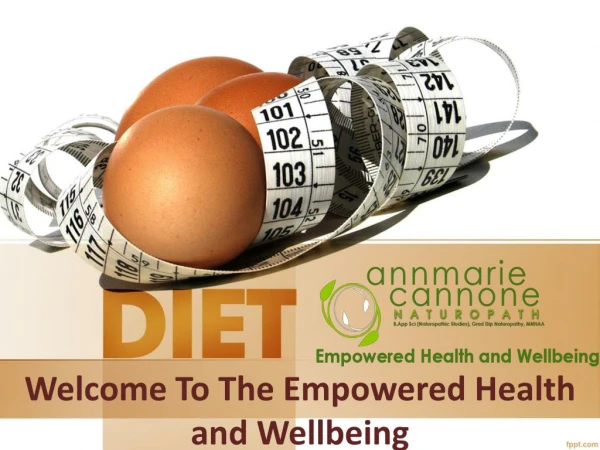
Herbal Medicine in Australia
Empowered Health Wellbeing provide western herbal medicine in Australia. To know about for more info visit us at :- http://www.empoweredhealthwellbeing.com.au/services/western-herbal-medicine/.
321 views • 7 slides

Herbal Medicine - http://www.divineayurvedayoga.com/
To make sure quality and strength in your herbal remedies, why not grow up your own? Study to concoct easy home remedies with these easy-to-grow medicinal herbs. http://www.divineayurvedayoga.com/
641 views • 39 slides
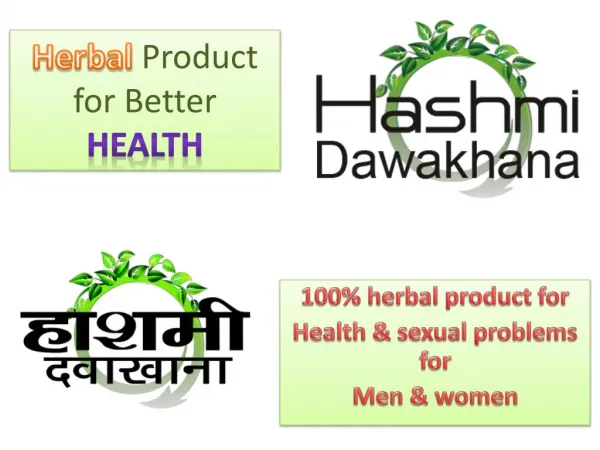
hashmidawakhana.co.in - herbal medicine
Herbal Medicines - Manufacturer, exporter and supplier of Herbal Healthcare Products
313 views • 8 slides

Herbal Medicine manufacturers
Contact Brilltech Engineers at: http://www.busductmanufacturers.com/bus-duct.html, A reliable Sandwich Bus Duct manufacturers suppliers offers all kinds Bus Duct manufacturers at competitive price.
381 views • 10 slides
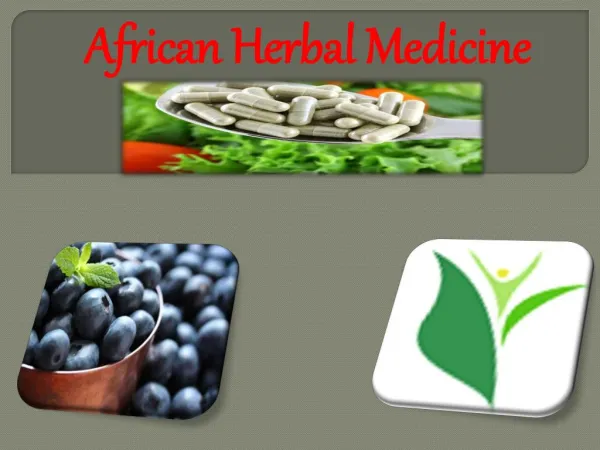
African Herbal Medicine
Seeing how helpful Jobelyn is for the stressed circulatory system in Sickle Cell Disease patients, it’s a small step to recognize how helpful it is for cardiovascular health in general. The medical community now views free radical oxidation and ongoing inflammation as primary contributors to heart disease, cholesterol build-up, and arteriosclerosis (severe thickening and hardening of artery walls).
170 views • 8 slides

PURE HERBAL MEDICINE PRODUCTION
Pure Herbal has tested its products in an internationally approved laboratory in India to make sure about the quality and standards which is needed to enter the international market. Allele Life Science Ltd have confirmed the quality of our products after doing standard tests include Trace Analysis, Component Analysis and Microbial Analysis. If you interested for buy products visit at http://pureherbal.af/gallery and contact us 93776661910 Shar-e New Chara-e Haji Yaqoob Street 2 House 66 Kabul AFG
153 views • 4 slides
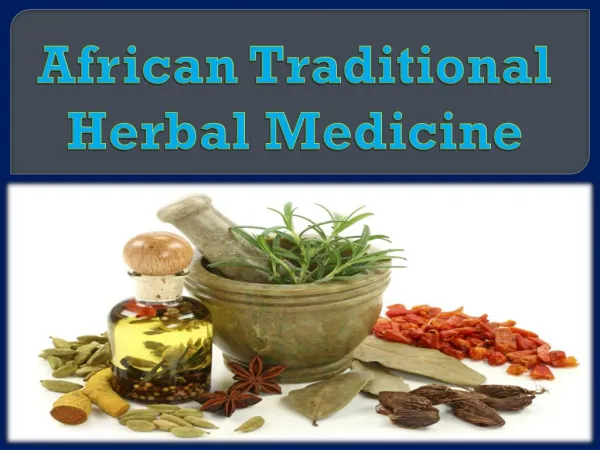
African Traditional Herbal Medicine
Welcome to African Traditional Medicine Site.This website has the objective of telling the story of a herbal product that was developed from African folk medicine which had been in use for centuries by people of South Western Nigeria to treat and cure diseases of diverse origin including
579 views • 18 slides

Herbal Medicine Market
Global Herbal Medicine Market Information by Product Type (Herbal Pharmaceutical, Herbal Dietary Supplements, Herbal Functional Foods & Others), Type of Medicinal Plants (Aconitum ferox, Allium sativum, Andrographis paniculata, Commiphora weightii & Crocus sativus), By Form (Capsules & Tablets, Powder, Syrups and Extracts), By Source (Leaves, Roots & Barks, Whole Plant & Fruit), By Indication (Cardiovascular Disorders, Respiratory Disorders, Digestive Disorders and Hypnotics & Sedatives), By Distribution Channel (Hospital & Retail Pharmacies and E-Commerce), By Region (North America, Europe, Asia Pacific, The Middle East & Africa (MEA) and Latin America) - Forecast to 2023.
55 views • 3 slides
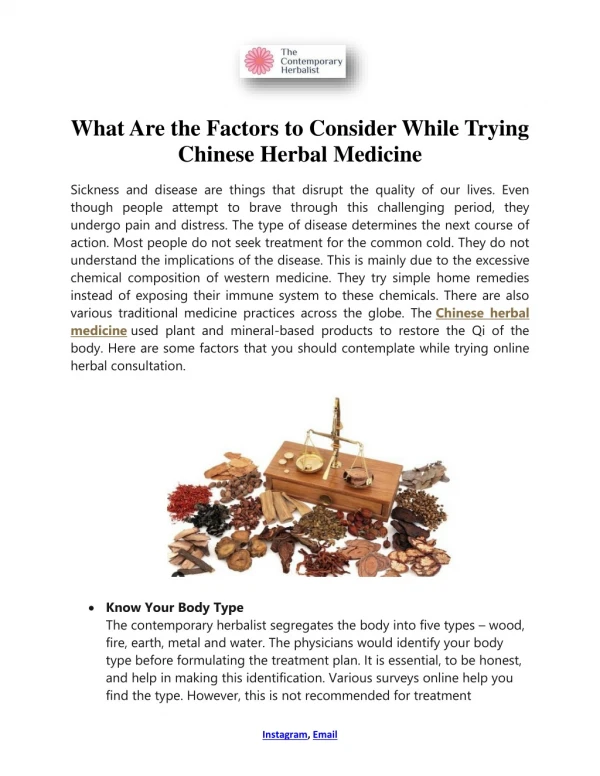
The Contemporary Herbalist is launching online books and resources for health and wellness. The website has books and resources that are simplified and condensed material of Chinese herbal medicine. For further information, pay a visit to https://www.thecontemporaryherbalist.com/
45 views • 2 slides

Herbal Medicine. Kelly Drake HW499 Bachelor’s Capstone in Health and Wellness Purdue University. Herbal Medicine. What is Herbal medicine? Traditional Chinese and Ayurvedic Medicine What are herbs? Plant Based Different Medicinal and Chemical Constituents. How Herbs Are Prepared.
199 views • 9 slides
Preparation & Use of Herbal Medicine
Water-based preparations.
Our members are aware of the importance of medicines being sourced from reputable manufacturers, who maintain consistent quality standards. Traceability (right back to the original batch of herbs) and certificates of authenticity are key ways in which quality is maintained. Sustainability is also of crucial importance.
- Infusions: dried or fresh herbs, usually aerial parts, steeped in boiling water
- Decoction: usually harder plant material, boiled on the stove for longer than infusions
- Syrups: herbs incorporated into a thick, sweet liquid
- Poultices: moistened herbs kept in place by a cloth for localised healing
- Lotions: infusions or decoctions delivered in a smooth liquid preparation
- Compresses: generally a soft cloth wrung out of a hot or cold infusion or decoction and applied to the affected area
Other preparations commonly used
Alcohol-based preparations usually called Tinctures. There are non-alcoholic alternatives to this such as glycerites or vinegars which are taken in the same way. Oil-based preparations such as infused oils and ointments are used externally.
- Powders taken internally and applied externally, may come in loose form or in capsules
- Juices are very nutritive
- Creams are often preferred in the treatment of skin conditions
- Steam inhalations
- Baths and skin washes
- Gargles and mouthwashes
- Pessaries and suppositories

IMAGES
COMMENTS
Dosage forms of herbal medicinal products Dosage forms are the means by which drug molecules or plant parts are delivered to sites of action within the body. The routes for which herbal dosage forms may be administered include oral, rectal, topical, parenteral, respiratory, nasal, ophthalmic and otic [8]. Categorization of finished herbal ...
Herbal medicine and herb-drug interactions. Herbal medicine and herb-drug interactions. Charlotte Gyllenhaal, Ph.D. Department of Medicinal Chemistry and Pharmacognosy and Block Center for Integrative Cancer Treatment 6-1870, [email protected]. Outline. Evidence for herb-drug interactions. 924 views • 42 slides
Excipients used in formulation of Liquid dosage forms: Excipients play an important role in the formulation of Liquid dosage forms. Liquid formulation needs a meticulous blend of ingredients to perform various functions like wetting and solubilization, stabilization, and imparting suitable color, taste, and viscosity. List of Excipients with ...
Finished herbal products are presented in various dosage forms such as decoctions, herbal powders, alcoholic beverages, capsules, tablets, ointments and creams.
Traditional Chinese medicine. The daily dose for individual non-toxic herbs in traditional Chinese medicine is usually in the range of 3 to 10 g, given as a decoction or in pill or powder form. 1 Often higher doses are prescribed by decoction than for pills, as might be expected since not all active components readily dissolve in hot water. 2 (Pills generally consist of the powdered herb ...
An overview of the various herbal dosage forms commonly available and their stability considerations is presented, which will help in the production of safe, stable and efficacious herbal medicinal products for use. There has been an upsurge in the use of herbal medicinal products across both developing and advanced countries. Finished herbal products are presented in various dosage forms such ...
As aforementioned the therapeutic effect of herbal medicines is exerted due to the presence of different constituents and the effects are further potentiated when compatible herbals are formulated ...
Herbal medicine is the use of plants for medicinal purposes. Modern medicine r ecognizes herbalism as a form of a lternative medicine. Modern medicine d oes make use of many plant derived . HERBAL MEDICINE. Compounds as the basis for pharmaceutical drugs. Herbs can be Slideshow 2705807 by
Syrups: herbs incorporated into a thick, sweet liquid; Poultices: moistened herbs kept in place by a cloth for localised healing; Lotions: infusions or decoctions delivered in a smooth liquid preparation; Compresses: generally a soft cloth wrung out of a hot or cold infusion or decoction and applied to the affected area
The present article is enriched with past and most recent literature on processing crude herbs, the necessity of standardization of herbal products, the health benefits of standardized herbal ...